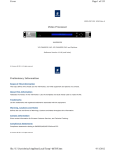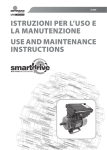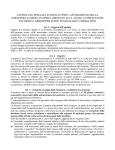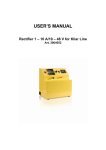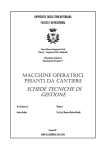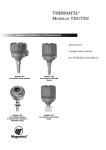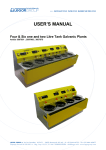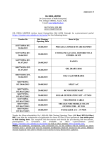Download Foglio dati prodotto - MD E-Shop
Transcript
ELEVATORE TELESCOPICO TELESCOPIC ELEVATOR ELV 80 ELV 100 ELV 120 MANUALE DI USO E MANUTENZIONE USER MANUAL ITALIANO - ENGLISH MD - MUSICAL ACCESSORIES di Dino Mazzocchitti Zona Industriale Piane di S. Andrea 64032 Atri (TE) – ITALY tel. +39 085 8780125 – fax +39 085 8793077 P.I. 00724830674 www.mdmusicalaccessories.com Edizione 06/08 - Edition 06/08 Indice / Index 1.Norme ed avvertenze generali / Norms and general instructions 2.Recapiti del costruttore e servizio post-vendita / Manufacture’s address and customer service 3.Dati tecnici / Technical notes 4. Descrizione / Description 5.Trasporto / Transport 6.Sollevamento / Lifting 7.Discesa / Lowering 8.Manutenzione / Maintenance 9.Sicurezza / Safety ELEVATORE MODELLO /ELEVATOR MODEL ELV 80 ELEVATORE MODELLO /ELEVATOR MODEL ELV 100 ELEVATORE MODELLO /ELEVATOR MODEL ELV 120 3 4 5 8 9 10 14 14 16 18 18 18 Il presente manuale è di proprietà della MD. MD si riserva il diritto di apportare, in qualsiasi momento e senza preavviso, modifiche per ragioni tecniche o commerciali. La riproduzione di qualsiasi parte di questo manuale è vietata ai sensi di legge senza autorizzazione scritta della MD. This user manual remains the property of MD MD reserves the right to modify the specifications at any time and without warning for technical or commercial reasons. Reproduction of any part of this manual without written permission from MD is forbidden, according to law. 1. Norme ed avvertenze generali / Norms and general instructions Il presente fascicolo, relativamente alla tipologia dell’elevatore telescopico “ELV80 – EVL 100 – ELV 120” considerato, costituisce uno strumento dettagliatamente preposto all’uso e alla messa in servizio in condizioni di sicurezza. Lo scopo del manuale, documentato ed illustrato, è quello di limitare la richiesta di assistenza al fabbricante garantendo agli operatori, a cui è dedicato, una corretta gestione, evitandone o limitandone i rischi connessi con l’utilizzo. This manual is specifically designed for the safe setting up and use of the “ELV80 – ELV100– ELV 120” telescopic elevator. The aim of this detailed and illustrated manual is to limit the need for assistance from the manufacturer, while providing instructions for the correct use of the ELEVATOR, to minimise any potential risks associated with its use. ATTENZIONE! Operatori e tecnici, devono leggere e comprendere l’intero contenuto del presente manuale. Il presente manuale e tutta la documentazione allegata, deve essere conservata per l’intero ciclo di vita dell’elevatore, in un luogo accessibile a tutto il personale preposto al sua utilizzo ed alla manutenzione. WARNING! Users and technicians must read and understand the full content of this manual. This manual and all of the enclosed documentation must remain accessible to the personnel in charge of the use and maintenance of the ELEVATOR for its full working life. Il Manuale di istruzioni è da considerarsi parte dell’ ELEVATORE , e deve essere conservato per futuri riferimenti fino all’eventuale smantellamento definitivo dello stesso. Sarà cura degli operatori conservarlo in modo idoneo in un apposito vano, noto a tutti gli operatori, protetto dall’umidità e dai raggi solari. Si informano gli utenti che il manuale rispecchia lo stato della tecnica al momento della commercializzazione; eventuali successivi aggiornamenti in base a nuove esperienze non lo renderanno in alcun modo inadeguato. This user manual is to be considered part of the ELEVATOR, and must be kept for future reference for its full working life. The users are asked to keep these instructions in a proper manner in an assigned location known to all of the users, away from humidity and light. The users should be aware that this manual reflects the state of the art at the moment the ELEVATOR was made available for purchase; any later updates on the basis of new experience will not render it unsuited in any way. 3/18 2. Recapiti del costruttore e servizio post-vendita / Manufacture’s address and customer service Il costruttore è disponibile per fornire tutte le informazioni relative all’uso e alla manutenzione dell’ ELEVATORE oggetto di questo manuale. The manufacturer is available to provide all information related to the use and maintenance of the ELEVATOR described in this manual. Qualsiasi richiesta di intervento o informazione deve essere indirizzata al Servizio Tecnico di Assistenza: Any repair or information request should be addressed to the Technical Support Services: MD - MUSICAL ACCESSORIES di Mazzocchitti Dino Zona Industriale Piane di S. Andrea 64032 Atri (TE) – ITALY tel. +39 085 8780125 fax +39 085 8793077 P.I. 007248300674 www.mdmusicalaccessories.com ATTENZIONE: Prima di contattare la MD annotarsi i dati dell’ELEVATORE riportati nella targhetta di identificazione. WARNING: Before contacting MD, please note all of the data related to the ELEVATOR that is shown on the identification label. ATTENZIONE PERICOLO! Si fa presente che alcuni ricambi rivestono caratteristiche di sicurezza delle persone; si fa quindi divieto di utilizzare ricambi diversi da quelli originali. Il cliente dovrà obbligatoriamente acquistare ricambi originali i quali possono garantire il funzionamento dell'ELEVATORE in sicurezza. WARNING DANGER! Some replacement parts include security features for the user; original replacement parts must always be used. The customer must purchase original replacement parts in order to guarantee the safe use of the ELEVATOR. 4/18 3. Dati tecnici / Technical notes Modello / Model ELV 80 • • • • • • • • • • • • • • • • • • • • • • • • • • • • Elevatore destinato al sollevamento di carichi verticali a differenti altezze Carico massimo sollevabile 150 kg Carico minimo sollevabile 40 kg Peso 55 kg Sollevamento del carico su sistema telescopico guidato a 2 sfilate Cavo di sollevamento in acciaio a due strati di trefoli antigirevole UNI 7302-74 – Ø5 mm – carico di rottura minimo 1800 kg Argano di sollevamento portata max 240 Kg con dispositivo di bloccaggio del carico a norme CE Struttura interamente in acciaio S235 JR Pulegge e perni in acciaio ad alta resistenza Superfici protette da corrosione da zincatura elettrolitica e/o verniciatura a polveri epossidiche Sistema di bloccaggio di ogni sfilata tipo AUTO-LOCK Dispositivo per livellamento a terra sui 4 lati dell’elevatore Ingombri come da figure riportate di seguito Piedini di appoggio a base circolare Ø90 mm basculanti Elevator for vertical load lifting to different heights Maximum load 150 k 330 lbs Minimum load 40 k 90 lbs Weight 55 kg /120 lbs Load lifting on telescopic system supplied by two profiles Two-strand, twist-resistant steel lifting cable UNI 7302-74 – Ø5 mm – minimum failure load, 1800 kg/3960 lbs Lifting winch maximum capacity 240 kg/530 lbs, with load-braking device, satisfying CE regulations Whole structure made of S235 JR steel Pulleys and pins made of high resistance steel Surfaces protected from corrosion by galvanisation and/or epoxy powder varnish AUTO-LOCK blocking system for each profile Ground levelling device on four sides of the elevator Overall dimensions as given in the figures below Adjustable stabilising feet with circular base of Ø90 mm 5/18 Modello / Model ELV 100 • • • • • • • • • • • • • • • • • • • • • • • • • • • • Elevatore destinato al sollevamento di carichi verticali a differenti altezze Carico massimo sollevabile 200 kg Carico minimo sollevabile 50 kg Peso 70 kg Sollevamento del carico su sistema telescopico guidato a 3 sfilate Cavo di sollevamento in acciaio a due strati di trefoli antigirevole UNI 7302-74 – Ø5 mm – carico di rottura minimo 1800 kg Argano di sollevamento portata max 600 Kg con dispositivo di bloccaggio del carico a norme CE Struttura interamente in acciaio S235 JR Pulegge e perni in acciaio ad alta resistenza Superfici protette da corrosione da zincatura elettrolitica e/o verniciatura a polveri epossidiche Sistema di bloccaggio di ogni sfilata tipo AUTO-LOCK Dispositivo per livellamento a terra sui 4 lati dell’elevatore Ingombri come da figure riportate di seguito Piedini di appoggio a base circolare Ø90 mm basculanti Elevator for vertical load lifting to different heights Maximum load 200 kg/440 lbs Minimum load 50 kg/110 lbs Weight 70 kg/154 lbs Load lifting on telescopic system supplied by three profiles Two-strand, twist-resistant steel lifting cable UNI 7302-74 –- Ø5 mm – minimum failure load, 1800 kg/3960 lbs Lifting winch maximum capacity 270 kg/600 lbs, with load-braking device, satisfying CE regulations Whole structure made of S235 JR steel Pulleys and pins made of high resistance steel Surfaces protected from corrosion by galvanisation and/or epoxy powder varnish AUTO-LOCK blocking system for each profile Ground levelling device on four sides of the elevator Overall dimensions as given in the figures below Adjustable stabilising feet with circular base of Ø90 mm 6/18 Modello / Model ELV 120 • • • • • • • • • • • • • • • • • • • • • • • • • • • • Elevatore destinato al sollevamento di carichi verticali a differenti altezze Carico massimo sollevabile 300 kg Carico minimo sollevabile 50 kg Peso 97 kg Sollevamento del carico su sistema telescopico guidato a 3 sfilate Cavo di sollevamento in acciaio a due strati di trefoli antigirevole UNI 7302-74 – Ø5 mm – carico di rottura minimo 1800 kg Argano di sollevamento portata max 908 Kg con dispositivo di bloccaggio del carico a norme CE Struttura interamente in acciaio S235 JR Pulegge e perni in acciaio ad alta resistenza Superfici protette da corrosione da zincatura elettrolitica e/o verniciatura a polveri epossidiche Sistema di bloccaggio di ogni sfilata tipo AUTO-LOCK Dispositivo per livellamento a terra sui 4 lati dell’elevatore Ingombri come da figure riportate di seguito Piedini di appoggio a base circolare Ø90 mm basculanti Elevator for vertical load lifting to different heights Maximum load 300 kg/661 lbs Minimum load 50 kg/110 lbs Weight 97 kg/214 lbs Load lifting on telescopic system supplied by three profiles Two-strand, twist-resistant steel lifting cable UNI 7302-74 – Ø5 mm – minimum failure load, 1800 kg/3960 lbs Lifting winch maximum capacity 270 kg/1322 lbs, with load-braking device, satisfying CE regulations Whole structure made of S235 JR steel Pulleys and pins made of high resistance steel Surfaces protected from corrosion by galvanisation and/or epoxy powder varnish AUTO-LOCK blocking system for each profile Ground levelling device on four sides of the elevator Overall dimensions as given in the figures below Adjustable stabilising feet with circular base of Ø90 mm 7/18 4. Descrizione / Description La torre di elevazione è progettata è costruita per il sollevamento del carico e suo successivo posizionamento ad altezze stabilite (come indicato in fig. 3). In alcun modo l’elevatore deve essere utilizzato per scopi diversi da quelli prescritti dal costruttore. Una volta sollevato il carico l’elevatore è predisposto con sistemi meccanici di bloccaggio delle sfilate che di fatto lo rendono come una struttura fissa. The elevator tower is designed and built for the lifting of loads and their subsequent positioning at specific heights (as shown in Fig. 3). The elevator must not be used for any purposes that differ from those defined by the manufacturer. Once a load has been lifted, the elevator is supplied with mechanical systems for the blocking of the profiles that renders it similar to a solid structure. figura 4 / figure 4 1 – Piede retraibile con sistema a cerniera / Foldable leg with hinge system 2 - Ruote per il trasporto manuale / Wheels for manual transport 3 – Argano / Winch 4 – Piedino di appoggio basculanti / Stabilising support foot 5 – Cavo in acciaio / Steel cable 6 – 7 – 8 - Volantino per bloccaggio meccanico ad attrito della sfilata / Hand-wheel bolts for friction blocking of the profiles 9 – 10 – 11 – Perno a molla per atobloccaggio delle sfilate in posizione / Spring pins for the locking of the profiles in the desired position 12 – Bolla per livellamento / Spirit level 13 – Supporto tiranti di sicurezza L’elevatore è realizzato in maniera da occupare un ingombro minimo quando non viene utilizzato. I quattro piedi che assicurano la stabilità all’elevatore durante il normale esercizio, sono reclinabili sul corpo dell’elevatore stesso che a sua volta è predisposto per il loro bloccaggio. Il sollevamento delle sfilate (e quindi del carico), avviene tramite un sistema di carrucole fisse e mobili azionate dalla fune in acciaio che si avvolge sull’argano. Quando si agisce sull’argano nel senso di avvolgere il cavo le sfilate vengono sollevate fino a che non arrivano alla posizione di fine corsa previsto per ciascuna di esse. The elevator is built so as to occupy the minimum of room when it is not in use. The four legs, which assure the stability of the elevator during use, fold into the body of the elevator itself, with safety catches. The lifting of the profiles (and hence of the load) occurs by means of a system of fixed and moving pulleys operated by the steel cable that wraps around the winch. When the winch is wound, the profiles are lifted until they reach the end of their designed movement. Le operazioni sono completamente manuali. All of the operations are carried out manually. 8/18 5. Trasporto / Transport L’elevatore è provvisto di maniglia e ruote per facilitare le operazioni di trasporto manuale. Inclinare l’elevatore dalla parte delle ruote tenendolo ben saldo sull’ impugnatura evidenziata in figura. ATTENZIONE: L’elevatore deve essere trasportato soltanto quando è completamente chiuso e tutte le sicurezze devono essere inserite. The elevator is supplied with a handle and wheels to facilitate its manual transport. Tilt the elevator on the same side as the wheels, keeping a firm grip on the handle indicated in the Figure. WARNING: The elevator must be transported only when it is completely folded and all of the security devices have been engaged. 9/18 6. Sollevamento / Lifting Estrarre la copiglia di sicurezza e sfilare il perno Pull out the safety catches and remove the pin Ruotare e portare in posizione il puntone Unfold the strut into position Ruotare il piede fino a terra Unfold the leg until it reaches the ground Reinserire il perno estratto al punto 1 tra il puntone e il piede. IMPORTANTE: reinserire la copiglia di sicurezza! Reinsert the pin removed above, through the strut and the leg WARNING: Reinsert the safety catch! 10/18 Ripetere le stesse operazioni per gli altri piedi Follow the same procedure for the other legs Utilizzando l’asta in dotazione eseguire il posizionamento verticale dell’elevatore. Registrare tutti i puntoni fino a che i piedini non toccano il suolo. IMPORTANTE: A fine fase verificare che la base del piantone centrale dell’elevatore aderisca al suolo altrimenti, registrare di nuovo i puntoni fino a che tale circostanza non sia raggiunta! Using the spirit level provided, ascertain the vertical positioning of the elevator. Fine set all of the struts until the feet touch the ground. WARNING: At the end of this operation, check that the column base remains in contact with the ground; if not, fine set the feet again until it is! Prima di proseguire con le operazioni di sollevamento verificare, tramite l’utilizzo della bolla, che l’asse dell’elevatore sia perfettamente verticale. La bolla deve trovarsi all’interno della circonferenza tracciata al centro del supporto. Nel caso in cui non vi sia un perfetto allineamento verticale dell’elevatore operare nuovamente delle registrazioni sui puntoni. Before continuing to the lifting operations, use the spirit level to verify that the long axis of the elevator is perfectly vertical. The bubble must be within the circle drawn in the centre of the holder. In case of a non-perfect vertical alignment, reset the leg struts. IMPORTANTE: Prima di proseguire con le operazioni di sollevamento eseguire la messa a terra dell’elevatore utilizzando cavi a norma. WARNING: Before proceeding with lifting operations, earth electrically the elevator using standard cables. 11/18 Allentare il volantino e disinserire il perno a molla. Per disinserire il perno a molla è necessario tirare l’impugnatura verso l’esterno e girare di 90° affinché questo resti in posizione. Slacken the hand-wheel bolt and pull out the spring pin. To unlock the spring pin, it is necessary to pull it out and to rotate it 90° to lock it into position. Agire sull’argano come indicato in figura, in modo da realizzare la prima fase di sollevamento. Arrestare l’azione sull’argano nel momento in cui si scopre il foro di bloccaggio sulla prima sfilata. ATTENZIONE: Per Informazioni specifiche riguardo l’argano far riferimento al manuale relativo in allegato Wind the winch as shown in the figure, to start the first phase of the lifting. Stop winding on the winch when a blocking hole is visible in the first profile. Armare il perno a molla ruotando di 90° l’impugnatura. Il sistema AUTO-LOCK scatterà nel momento in cui la sfilata è arrivata a fine corsa. Set the spring pin by rotating it 90°. The AUTO-LOCK system will click the pin into position when the profile reaches the end of its movement. WARNING: For specific information regarding the winch, refer to the related manual that is enclosed. 12/18 Agire sull’argano ed eseguire sollevamento della sfilata. il completo A termine del sollevamento completo della sfilata ATTENZIONE: durante questa fase l’operatore deve controllare visivamente il carico in sollevamento. L’operazione deve essere eseguita lentamente. Wind the winch to fully lift the profile. serrare il volantino come indicato in figura. ATTENZIONE: eseguire questa operazione soltanto dopo che sia scattato il perno a molla! At the end of the full lifting of the profile, lock the hand-wheel bolt as shown in the figure. WARNING: WARNING: During this phase the operator must visually Carry out this operation only after the spring pin has clicked into place! follow the load being lifted. This operation must also be carried out slowly. 13/18 Con le stesse operazioni elevare la torre all’altezza massima o, intermedia. Per queste operazioni agire sui dispositivi di bloccaggio e sicurezza numeri 6-7 e 9-10 di figura 4. Repeat this procedure to lift the tower to its maximum or intermediate heights. For these procedures, use the blocking and safety devices indicated by 6-7 and 9-10 in Figure 4. 7. Discesa / Lowering Per le fasi di discesa eseguire le stesse operazioni per la salita a ritroso. Sganciare il perno a molla (num. 9 fig. 4), allentare il volantino ( num. 6 fig. 4) e procedere con la discesa tramite l’argano. Terminata la prima fase di discesa provvedere al reinserimento dei dispositivi di sicurezza (numero 9 e numero 4). Procedere allo stesso modo per le altre fasi di discesa. For the lowering phase, follow the same operations for the lifting, in reverse. Pull out the spring pin (reference 9, Figure 4), slacken the hand-wheel bolt (reference 6, Figure 4) and proceed with the lowering using the winch. Once the first lowering phase is finished, reinsert the safety devices (references 9 and 4, Figure 4). Proceed similarly to lower the other sections. 8. Manutenzione / Maintenance Verificare periodicamente lo stato di usura del cavo. Qualora dovesse presentare anche la minima abrasione sostituirlo immediatamente con uno originale. Si raccomanda di lubrificare periodicamente i cinematismi del'elevatore (grasso per catene a base siliconica). I cuscinetti sono tutti schermati. Nel caso in cui si avverte rumorosità nei sistemi rotanti dell’elevatore si raccomanda di eseguire una verifica ispettiva e una nuova lubrificazione. Periodically check the wear of the cable. If it shows any signs of abrasion, replace it immediately with a new original cable. It is reccomended to lubricate the moving parts of the elevator perdiodically (chain grease with silicon base). The bearings are all covered. In the case of noise arising from the moving parts of the elevator, inspection and lubrication is recommended ATTENZIONE: L’argano dispone di un sistema autofrenante che non deve essere mai lubrificato! WARNING: The winch has an autobraking system that must never be greased! 14/18 Per manutenzioni specifiche dell’argano far riferimento al manuale di uso e manutenzione allegato. Al fine di garantire nel tempo la funzionalità e la sicurezza dell’elevatore il costruttore raccomanda l’utilizzo di ricambi originali. Nel caso di inutilizzo non lasciare l’elevatore allo scoperto o comunque sotto l’azione degli agenti atmosferici. In caso di anomalie o malfunzionamenti non risolvibili con le manutenzioni ordinarie riportate nel seguente libretto contattare il costruttore. Nel caso sia necessario contattare il costruttore annotarsi i dati riportati sulla targhetta prima di chiamare. For specific maintenance procedures of the winch, refer to the enclosed user manual. To guarantee continued function and safety of the elevator, the manufacturer recommends the use of original replacement parts. When not in use, do not leave the elevator outdoors or exposed to the action of atmospheric agents. In case of anomalies or problems not resolvable through the ordinary maintenance quoted in this manual, contact the manufacturer. In case of the need to contact the manufacturer, note the data shown on the identification label before calling. La taratura della bolla avviene di fabbrica. Periodicamente verificare la taratura della bolla tramite un livello e agendo sulla vite di registrazione che si trova immediatamente al di sotto della bolla stessa. The calibration of the spirit level is carried out in the factory. Periodically check the calibration of the spirit level using a reference spirit level and adjusting the setting screw that is located below the spirit level itself. La taratura della bolla (numero 12 fig. 4) deve essere operata tramite livellamento dell’elevatore come indicato in figura. Il livellamento verticale deve essere eseguito su due lati perpendicolari tra loro del piantone centrale dell’elevatore. Per eseguire la taratura della bolla agire sulle viti riportate in figura. The calibration of the spirit level (reference 12, Figure 4) must be carried out by level checking of the elevator as shown in the Figure. The vertical levelling must be carried out on two sides at right angles to each other, each on the central column of the elevator. To carry out the calibration of the spirit-level, operate on the screws as shown in the Figure. 15/18 9. Sicurezza / Safety L’elevatore va utilizzato solo su suoli solidi e piani. Prima di eseguire le operazioni di sollevamento deve essere livellato in maniera da risultare in posizione perfettamente verticale Durante le operazioni di salita e discesa l’operatore deve controllare visivamente il carico e deve verificare che non ci siano anomalie di alcun genere Le operazioni di salita e discesa devono essere eseguite lentamente I sistemi di sicurezza e bloccaggio (numeri 6-7-8 9-10-11 fig. 4) devono essere sempre efficienti ed inseriti in qualunque posizione si trovi l’elevatore Le coppiglie di sicurezza dei perni sui puntoni devono essere sempre inseriti. In caso di utilizzo dell’elevatore all’aperto o comunque in presenza di vento assicurare la sua stabilità tramite tiranti (da collegare sulla parte alta dell’elevatore) The elevator must be used on solid and flat surfaces. Before carrying out the lifting procedures, the elevator must be levelled so that it is perfectly vertical. During the lifting and lowering phases, the operator must visually check the load and must verify that there are no problems. The lifting and lowering operations must be carried out slowly. The safety and blocking devices (references 6-7-8 9-10-11, Figure 4) must always be in full working order and in position at every stage of the elevator use. The safety catches of the pins located on the struts must always be reinserted If the elevator is used outdoors or where there is wind, make sure of its stability by using tie-rods (to be connected on the upper part of the elevator) In presenza di venti la stabilità dell’elevatore va assicurata tramite tiranti che vanno disposti come in figura. I tiranti devono essere inseriti sui quattro lati dell’elevatore ad una distanza minima dal centro dello stesso di 3 m! (particolare 13 figura 4) Non utilizzare altri sistemi di stabilizzazione dell’elevatore (es. aggiuntivi sui piedi)! For outdoor use or where there is wind, the stability of the elevator must be ascertained by using tie-rods, arranged as shown in the Figure. The tie-rods must be inserted on all four sides of the elevator (reference 13, Figure 4) at a minimum distance from its centre of 3 m! Do not use other stabilisation systems for the elevator (i.e. additional loads on the legs!) Non superare mai il carico massimo riportato sulla targhetta Durante le fasi di sollevamento e discesa l’area interessate deve essere sgombra da persone (ad eccezione dell’operatore addetto) Durante le fasi di sollevamento o discesa non appoggiarsi con le mani sulle sfilate mobili E’ fatto divieto assoluto di appoggiare scale o altri oggetti all’elevatore 16/18 E’ vietato sollevare persone E’ vietato sollevare dispositivi che inducano sollecitazioni aggiuntive all’elevatore (vibrazioni etc..) E’ vietato trasportare l’elevatore quando non si trova nella sua configurazione di chiusura massima (fig.1) Il carico applicato non deve essere sbilanciato!! Eseguire sempre la messa a terra con cavi a norma Do not exceed the maximum load shown on the label During the lifting and lowering phases, the area of operation must be free of people (except for the operator) During the lifting and lowering phases, do not touch the moving profiles Staircases or other objects must absolutely not be leant on the elevator People must absolutely not be lifted by the elevator Devices that can induce additional strain to the elevator (vibration, etc.) must not be lifted Only transport the elevator when it is in its fully folded configuration (Figure 1) The load applied must be balanced! Always to be earth electrically before use ATTENZIONE: Nonostante l’impegno del costruttore non tutti i rischi residui sono stati eliminati!!! WARNING: Despite the manufacturer’s efforts, all of the residual risks may not have been eliminated! 17/18 DICHIARAZIONE DI CONFORMITA’ CE EC CONFORMITY DECLARATION MD - MUSICAL ACCESSORIES di Mazzocchitti Dino Zona Industriale Piane di S. Andrea 64032 Atri (TE) – ITALY Tel. 085.8780125 – Fax 085.8793077 P.I. 007248300674 www.mdmusicalaccessories.com ELEVATORE MODELLO /ELEVATOR MODEL CARICO MASSIMO / MAXIMUM LOAD CARICO MINIMO / MINIMUM LOAD ALTEZZA MASSIMA / MAXIMUM HEIGHT ELV 80 150 kg / 330 lbs 40 kg / 90 lbs 4000 mm ELEVATORE MODELLO /ELEVATOR MODEL CARICO MASSIMO / MAXIMUM LOAD CARICO MINIMO / MINIMUM LOAD ALTEZZA MASSIMA / MAXIMUM HEIGHT ELV 100 200 kg/440 lbs 50 kg/110 lbs 5300 mm ELEVATORE MODELLO /ELEVATOR MODEL CARICO MASSIMO / MAXIMUM LOAD CARICO MINIMO / MINIMUM LOAD ALTEZZA MASSIMA / MAXIMUM HEIGHT ELV 120 300 kg/661 lbs 50 kg/110 lbs 6000 mm La ditta MD, firmataria della presente, dichiara sotto la propria esclusiva responsabilità, che l’elevatore oggetto del presente manuale è conforme a quanto prescritto dalle direttiva macchine 89/392 CEE e successive modifiche quando utilizzato per il sollevamento di carichi secondo quanto indicato nel manuale. The MD house, signatory of the present conformity declaration, under the own exclusive responsibility, states that the elevator, subject of the present manual, satisfy the Machinery Directive 89/392 CEE and amendments when used for lifting loads in accordance with the manual instructions. Dino Mazzocchitti Titolare / Owner 18/18


















